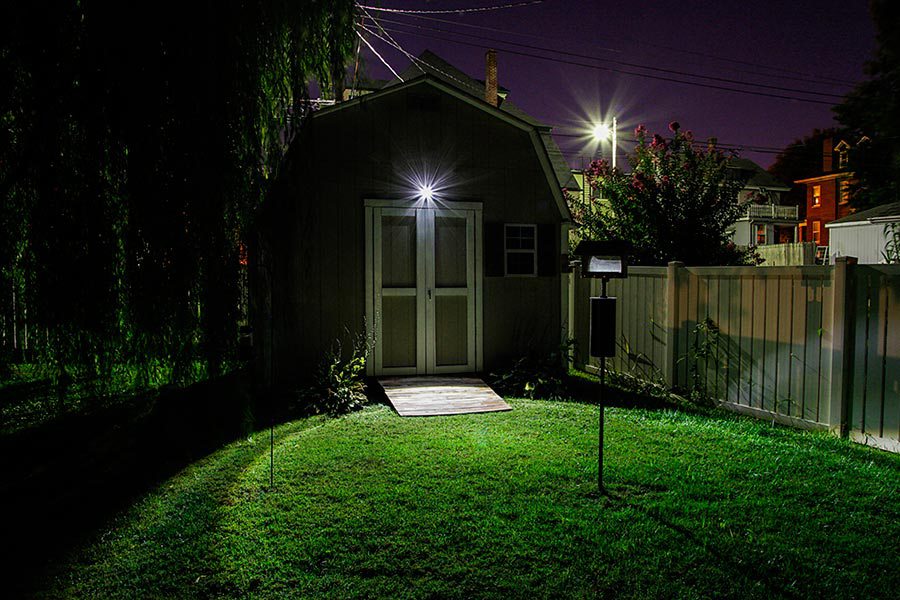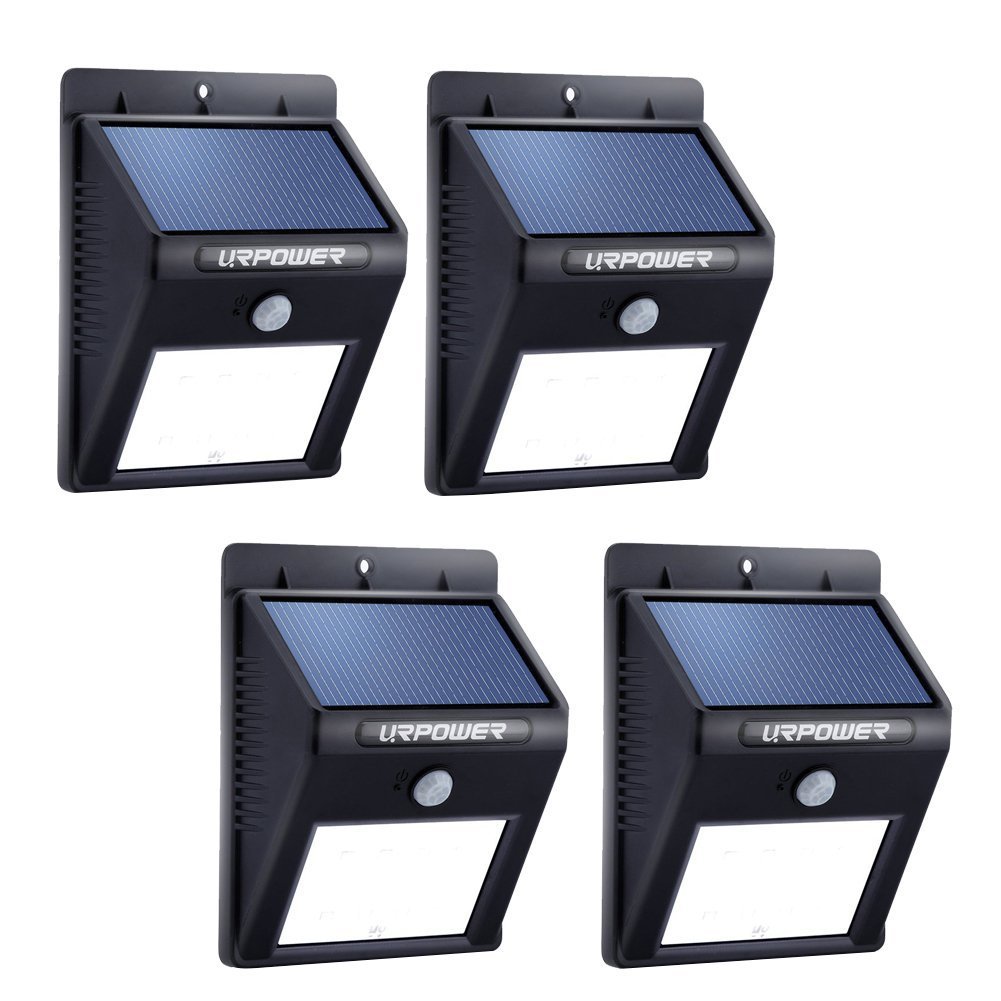
A Prepper Must-Have: Solar Spotlights
I hesitate to call these spotlights instead of just outdoor lighting, but they’re easier to search that way. I’m talking about any light options that can be set up by anyone who owns a screwdriver, no electrical connections needed, that runs off the sun and-or a spare battery, and that provides quality lighting when somebody walks inside its sensor range. The range of detection, amount of light, and hours of charge are going to vary by price and size, just like the amount of light it takes to charge them will vary by the quality of their solar panels.
These aren’t as inexpensive as some of the must-haves in preparedness like soap and rice. However, it’s not like I’m suggesting freeze-dried steaks or a .308 here, either. They’re not usually as small as a sheet or a set of bungee cords, but they also don’t need their own five-gallon buckets or trunks to store each backup. They don’t have quite the million and one uses of baking soda and they’re relatively stationary unlike headlamps.
Still, they’re readily affordable, fairly lightweight and small, and they can make a big, reliable difference for relatively small outlay – a difference that’s almost impossible to match with other products. That makes them a must-have in my book.
I’m pushing the solar aspect in this one case, because not everyone has a generator and even if we do, limiting the power draw during daily life and especially an emergency makes good sense.
Too, a light tied to even our personal grid is dependent on any of several single components to function. When one goes out, so do all the lights. With a set of independent solar-powered spotlights, we still have our security and safety lights.
I actually started down this road for three reasons. One: I hate power bills. Two: It’s really, really, really dark in the country compared to the ‘burbs. Three: The spaces on my parents’ property even to take the trash behind the garage is … mined. There are anthills, random rose bushes, baby trees, whatever Pops brought home from work last, dog and children’s toys, sometimes windblown fruit like apples, and routinely neighborhood animals and wildlife. No to mention record-setting web spinners and about 20 places for them to work.
Solar-powered motion-sensor lights help us dodge all of those. Plus, the kinds I picked are easy enough for even my non-techie, non-electrician mother and now-disabled father to install and maintain.
Unlike game cameras, a motion-sensor light lets us see what is upsetting dogs or livestock immediately, from our windows and porches, instead of looking the next day or requiring a wireless computer connection for real-time viewing, and are usually far less expensive.
I also like to have a fair chance of seeing what made the dogs go crazy, and my parents’ had a prowler at least three times a few years ago. To the rescue: motion activated lights, several sets that ranged from $30 to $60.
The peace of mind of knowing when it’s a loose cat and when it’s more is worth every penny to us. If there’s still a prowler, they’re staying way down at the road turn-off or way up past the dog lot now.
With motion-sensor lights, you can see what exactly is out there by the poultry or sheds or gardens and whether it’s nothing or an air gun versus an AR target, Moms can walk from her car to the house without hitting any puddles or icy patches, and you avoid getting annoyed at a bucket that doesn’t come when you call and can stalk right to a dog – or realize Stealthy Sam is standing two feet away looking at you waiting for the door to open.
There are lots of times, even in this perfect, fully powered country, that the motion-sensor lights have been valuable. A lot of those values will continue or cross over should there be a widespread disaster of some kind.
Increasing the Usefulness of your Lights
For a boost to the lights, consider covering with thin fabric or thinned paint in varying colors and shades to create not only illumination, but in some cases, to even alert to direction of travel. A full-on whitewash can be difficult to judge, even with a property lit up like a full moon.
Knowing that white means interior or corners, and knowing that red means something or someone circled a hen-house, hit the register between corner lights, or that something hit two sensors but not the adjacent 2-7, can help us decide what we most need and where our response should be focused.
These are just some examples of options available:
- URPOWER Solar Motion Sensor Lights, Pack of 4 $40-50 – (These are one of the sets we got my parents for eaves and the walls along the garbage-can path. Pretty good but need cleaned in Pollen-Crazy, U.S.A.)
- 3-PACK Wireless Solar Motion Sensor LED Security Light w/ Photocell, PIR Motion Sensor – $30-60
- Mr Beams MBN356 Networked LED Wireless Motion Sensing Spotlight System 6-Pack – $130-150 (Networked system, longer activation range than many small versions; requires D batteries)
Solar motion-sensor spotlights can also be purchased as single units. There are all kinds, some less expensive and other, much more expansive sets.
Pre-plan by looking at the height they’ll likely be placed, the area they’re intended to cover, and whether they’re there to illuminate the ground on a path or inform us of what’s out there in the night. That will help us make the most economical decisions regarding sensor range, light size, and the amount of money we want to invest.
Downsides to Solar Lights
Okay, so besides the sun-cloud thing, motion-sensor lights have a big issue for preppers: light discipline.
It’s really dark out there in the world when there’s no light. It’s why the military still trains people to use lights under a poncho in the open. The $0.97 stakes from Walmart may seem pitiful now, but they’re plenty to catch an eye in real darkness depending on the elevation, altitude, and flora or built environment around them.

If light discipline is of importance during an emergency, a higher-grade model with wireless remote or tied to a household switch may be more appropriate than the automatic, less-expensive models.
The cheapest of the lights don’t have on-off switches. Until you start getting into relatively pricey systems you don’t have an indoor switch option for the solar motion-sensor versions. That means if you’re trying to stay dark, you have to take them down and you’re back to handheld lights or maybe turning them on as you go.
On the other hand, let’s look at the history of disasters for a minute.
Most of our grid-down situations are temporary, and tend to relate to a localized or regional storm or somebody who dug or hit a line (or pole) or a piece of equipment that fritzed. Rolling brown-outs are something that used to be of issue, and could become so again.
Most of our financial reversals are serious on an individual/family level, or a slow decline due to a dying industrial area. There are some like 2008 that strike a lot of people over a relatively short amount of time, and there are some that are similar to Greece, Venezuela, Argentina, or even the Great Depression here and abroad.
Certainly crime increases in many of those situations, but they’re not total anarchy.
Perhaps lights would make urban or suburban dwellers a target in a Ferguson or Baltimore, and little twerps would be inclined to bust them up. In most of those cases, however, rioters tend to generally stay in areas that they live in or around civic centers. Only in L.A. so far have these things really spread significantly into other locations entirely, and a lot of those locations have been shopping areas and roadways in most recent riots. They haven’t started trashing the random ‘burbs so much.
And in all cases so far, nobody has thrown the light switch for the entire area to plunge it into darkness. Nobody has been hungry and assuming that a light means somebody’s there and has food.
So for most of our lives, just like the lives of our parents, our disasters are going to involve less blatant violence and less chance that motion-sensor lights really make us a target instead of the reverse: aiding our security and safety.
There are exceptions, and in those cases, maybe we do turn them off or take them inside. But they’re rare.
There is another downside besides the sun, and that would be: A battery-dependent anything depends on batteries. Batteries start with a terminal charge-discharge cycle, and tend to become less and less effective over time. Sometimes our cutesy solar lights run off common batteries of a type we can stockpile in a cool place, sometimes they have an unusual battery or specialty power pack.

Solar spotlights come with a variety of mounting options and some include long cords between the PV panels and lights. That allows us to place the light where we want it and still position the solar panel where it will collect the most energy.
Even if it’s the latter, and even if they’re lower-end, the wall-mounted solar lights tend to be pretty efficient boogers and LED lights tend to be pretty low-draw. There’s going to be a correlation to panel quality and size, light intensity and area coverage, alert zone size and accuracy, and the lifetime of the battery. Some pretty long-lived versions can be had for well under $100 easily, but those are aspects to consider as we gather information if we decide to buy them.
Solar lights also depend on that panel that’s sucking up light to power the device.
The best advice I can give is to buy the one with the best and most informative reviews, and make sure there’s a return policy that’s not going to cost half again as much to send it back. That way if an item feels a little bit cheap when it comes out of the box, we can put it right back in and try again. Doing so prevents regrets on day 32, 61, or 93 when we have that “I knew it” moment – right after a warranty or a replace-refund time period has elapsed and our receipt has gone … somewhere.
That kind of goes with anything, but especially with an item we’re buying so it’s safer and easier for us to maneuver around in darkness at our home or incorporating into our security systems.
Are Solar Lights Really Prepper Must-Haves?
In my world, yes. Being able to see at night, and further away than our porch lights, is huge for a ton of reasons.
Solar Light,URPOWER 8 LED Outdoor Solar Powerd,Wireless Waterproof Security Motion Sensor Light for Patio, Deck, Yard, Garden,Driveway,Outside Wall with 2 Modes Motion Activated Auto On/Off(4 Pack)
It makes my life safer from insects and tripping, prevents my dogs from tangling with an unseen raccoon, prevents us from having to go outside without knowing if the thing by the birds is animal or human, armed or a kid. It tells us if we’re in a “release the hounds” situation, a shotgun situation, or if we need to head out the side door and very quietly take one of the unlit paths that are worked in (because we’re freaks) because more trouble than it’s worth risking a life over is cutting through the gate chains, or one of the lights got shot out.
They’ll provide that service regardless of whether we’re home, the area has an outage, or the alarm is set.
And they’ll do some of it for less than $30-50 bucks, most for $50-100, and absolutely all for $100-200. The cost of sets is low enough for them to be holiday presents and still have something “fun” to ask for, or we could jump above the level that only requires a screwdriver and a thumb to install, and get a really nice system by setting back ten bucks a week or twenty bucks a month.
For some of us, that amount can be saved by skipping a couple of coffees or takeout, or changing or phone plans. Some of us have already cut the cord, but if we really want to become prepared and a $120 item isn’t even an annual option, it might be time to explore Prime, Hulu and Roku and ditch cable and the house phone (there are good free and low-cost VoIP house phone service out there – I use the Google one).
When something makes our life a whole lot easier in daily life, can prevent injury, and can help us keep our homes, gardens, pets and livestock safe, and can do it for <$100-150 bucks spent in $30-50 increments with an expanding system, I call that a must-have.
Teenagers sneaking in or out and those of us arranging for a surprise in predawn blackness may not agree. (Smile and encourage a sense of humor; life’s hard enough as it is.)
























